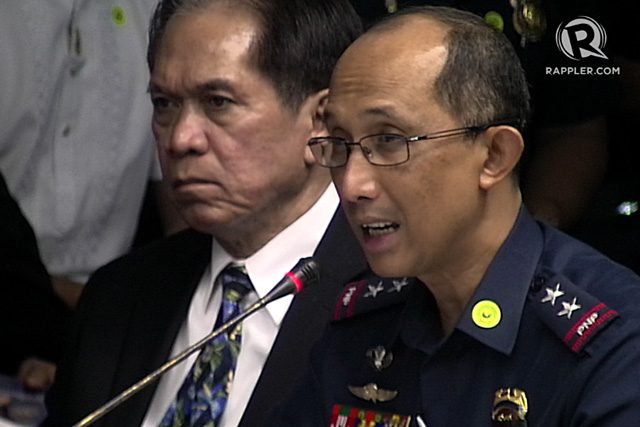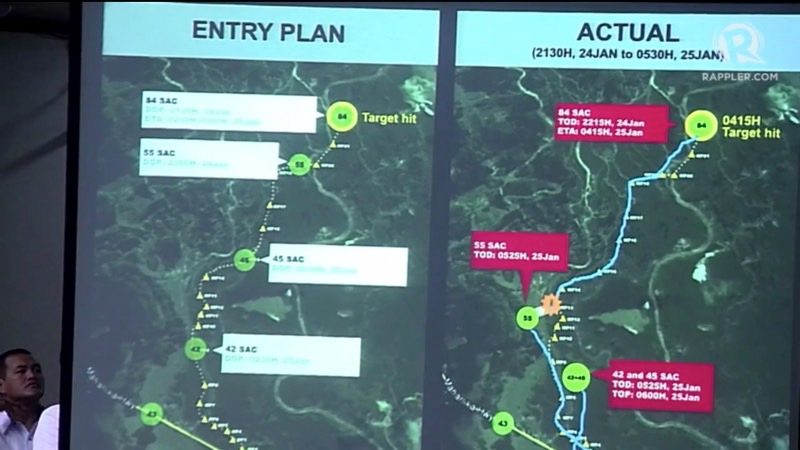SUMMARY
This is AI generated summarization, which may have errors. For context, always refer to the full article.

MANILA, Philippines – The odds were stacked against elite cops during “Oplan Exodus,” a January 25 operation to neutralize Jemaah Islamiyah terrorist Zulkifli bin Hir, better known as “Marwan”.
Although successful, the operation also resulted in the death of at least 68 individuals, including 44 elite cops from the Philippine National Police (PNP) Special Action Force (SAF).
The incident has prompted outrage in the country, with some sectors urging government to end peace talks with the Moro Islamic Liberation Front (MILF).
The 44 SAF troopers, collectively known as the SAF 44, died during an hours-long encounter with MILF and Bangsamoro Islamic Freedom Fighters (BIFF) in Mamasapano town, Maguindanao.
Although the BIFF split from the MILF over disagreements in talking peace with government, lines between the two groups blur in Mamasapano. It is where families and relatives, regardless of affiliations, reside together.
It’s one of the many pecularities government troopers had to face that day.
The elite cops deployed were experienced operators and veterans of the 2013 Zamboanga seige. Mamasapano, however, was a different animal.
According to the preliminary findings of the PNP’s Board of Inquiry, SAF troopers had to contend with “unfavorable terrain” described by probe chief Police Director Benjamin Magalong as a “marshland, criss-crossed by rivers, with wide open cornfields and irrigation canals.”
On top of that, Mamasapano was home to “a significant presence” of non-government forces. PNP SAF leadership, citing previously botched operations, decided to forego coordination with local military forces.
This decision eventually proved crucial during D-day. Without prior knowledge of the SAF’s plans, it was difficult for the military to come to their aid.
Gap between plan, actual ops
Only two SAF companies actually entered the area of operation: the 84th Seaborne Company as the ones tasked to kill Marwan and the 55th Special Action Company (SAC), the designated “blocking force” of the operation.
The two were supposed to link up as soon as “Mike One,” the SAF’s code for Marwan, was neutralized. It never happened.
“Except for the Seaborne Unit, the other units did not reach their designated positions,” said Magalong during the Senate probe into the events surrounding “Oplan Exodus.”
The US-trained Seaborne Unit – the “best of the best” in SAF – took close to two hours to get to their assigned area because of “difficult terrain and the strong river current near the target.”

Other groups – 4 assigned for support, two as the blocking forces, and two more for route security – were also delayed in their movements since they needed to be in sync with the Seaborne Company.
Marwan was killed by SAF troopers at around 4:15 am. “Mike One, Bingo,” read the SAF’s text to their commanders waiting a few kilometers away.
Things went awry soon after. By daybreak, troopers from the 55th SAC realized they were already surrounded by armed men. At 7 am, the 55th company’s radio man, Senior Inspect Ryan Pabalinas, called for help.
“Seaborne troops were determined to reinforce 55th SAC but because of the tremendous firepower and strength of the opposition, they were advised not to link up and instead move east,” noted Magalong.
Both companies by then were already “under heavy fire and mortar fire.”
“While moving, the Seaborne teams engaged various armed groups from all directions. For hours until late in the afternoon at around 1800 hours, they fought their way out, dragging their killed and wounded comrades,” said Magalong.
The Seaborne Company eventually joined forces with the 42nd SAC, the containment force assigned to ensure the exit of the 84th company.
Meanwhile, over the course of 8 hours, the 55th SAC would be annihilated by enemy combatants. Only one trooper from the blocking force survived to tell the tale of Mamasapano.
Results in a month
This early on, one thing is clear: the chain of command was not followed the moment now-resigned PNP chief Director General Alan Purisima was present during a January 9, 2015 briefing in Bahay Pangarap, the President’s official residence.
Already slapped with a preventive suspension order by then, Purisima told now-relieved PNP SAF commander Police Director Getulio Napeñas to inform PNP OIC Deputy Director General Leonardo Espina and Interior Chief Manuel Roxas II of the operation only after troops had entered Mamasapano.
Purisima, however, insists he was not ordering Napeñas but merely giving him advice. Napeñas, for his part, denied being the “bata” or prodigy of Purisima, contrary to news reports.
Police officials had earlier told Rappler that Napeñas is not closely associated with Purisima. But to get the plum post of SAF commander, one has to be in the good graces of a PNP chief.
As of February 8, the Board of Inquiry has completed 374 interviews and compiled 318 sworn statements, SMS and call logs, and reports from police units.
“From January 26 until today [February 9], 46 investigators have spent 5,152 man hours collecting the data,” added Magalong.
The Board of Inquiry is expected to release its findings in less than a month.
The probe will determine what lapses were committed in the planning and execution of “Oplan Exodus,” and which police personnel are accountable for them. – Rappler.com
DAY ONE: Senate probes ‘Oplan Exodus’
- AS IT HAPPENS: Senate hearing on PNP-SAF Mamasapano clash, day 1
- Espina to MILF: Why the ‘overkill’ of my men?
- Poe warns Napeñas of insubordination, misconduct
- Aquino, Purisima were at final ‘Oplan Exodus’ briefing
- Senators question MILF absence in SAF hearing
- Command or advice? Senators say Purisima story ‘incredible’
- Police, military generals face off over Mamasapano
- Why SAF didn’t trust military
- Sacked SAF commander: What drones?
Add a comment
How does this make you feel?
There are no comments yet. Add your comment to start the conversation.